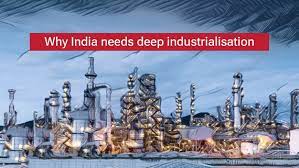
Need for Deeper Industrialization in India
Need for Deeper Industrialization in India
GS-3: Indian Economy
(UPSC/State PSC)
Important for Prelims:
Manufacturing Industry in India, Make in India vs Self-reliance, Production-Linked Incentives, PM Gati Shakti- National Master Plan, Bharatmala Project, Start-up India, Make in India 2.0, Self-reliant India Campaign, Special Economic Zones, MSME Innovative Scheme.
Important for Mains:
About deep industrialization, need for deep industrialization for India's growth and development, challenges before industrialization in India, way forward.
February 16, 2024
Why in news:
Currently, despite a relatively quick recovery from the pandemic, India faces challenges such as deindustrialization and persistent economic inequalities.
- For example, India's Atmanirbhar Scheme. Globally, the Inflation Reduction Act in the US, the European Green Deal and the like are prominent examples.
About Deep Industrialization:
- Intensive industrialization is different from traditional industrialization.
- Intensive industrialization moves forward with an emphasis on sustainable and inclusive growth while conventional industrialization generally refers to the process of developing industries in a region or country.
- Intensive industrialization aims to promote social welfare along with economic stability while conventional industrialization accelerates industrial expansion.
- It involves integrating industries with advanced technologies, promoting innovation and ensuring environmental and social responsibility.
Causes of need of Deep industrialization in India:
- To improve competitiveness in manufacturing, overcome the shortage of high-tech infrastructure and skilled manpower.
- Leading industrial manufacturing sector in India, as its contribution to the gross domestic product (GDP) has remained stagnant at around 16% since 1991.
- To improve adequate transport facilities as India's transport infrastructure is stressed due to overburdened rail network and various issues affecting road transport.
- To remove the constraints of MSME sector as MSME sector faces difficulties in obtaining loans as compared to medium and large scale industries. This bias needs to be corrected to support the growth of the MSME sector, which is critical to India's economic growth.
- Ending high dependence on imports as India is still dependent on foreign imports for various critical sectors including transport equipment, machinery, iron and steel, chemicals and fertilizers.
- The total industrial production of consumer goods in India contributes 38%. In newly industrialized countries like Singapore, South Korea and Malaysia this percentage is 52%, 29% and 28% respectively.
- To improve effective industrial policies as inefficiencies have arisen due to political interference, red tape and labour-management issues in the industrial sector.
- Promoting investment flow in all sectors of industry Since after liberalisation, substantial investment is coming in some industries, but the pace of investment in many basic and strategic industries like engineering, power, machine tools etc. has been considerable.
Challenges facing Industrialization in India:
Impact of deindustrialization in India after the pandemic:
- India is experiencing "deindustrialization" after recovering from the pandemic, where high growth benefits a small minority, exacerbating existing inequalities.
- Structural flaws: While expensive cars are being sold, common people are struggling with high food prices, highlighting the structural flaws in India's development model.
Disadvantages of Service-Based Development:
- The country has focused on service-driven growth since the late 1980s, but it has not absorbed labor from agriculture as effectively as manufacturing would have done.
- Lack of highly skilled workforce: The service sector of the country requires highly skilled workforce.
Inequalities in education:
- India's education system reflects deep inequalities, with investment in human capital favoring the elite. This has led to a lack of large-scale entrepreneurial ventures, unlike in China.
Lack of cultural factors in industrialization:
- A major cultural prerequisite for industrialization is mass education, which is lacking in India.
- Cultural devaluation of certain occupations required for manufacturing in India, as well as devaluation of vocational skills, hinders organic innovation and industrial progress.
Challenges in employment generation:
- India's labor market is characterized by low-paid and informal jobs. Most MSMEs are in the unorganized sector, which lack the flexibility to create employment. China's experience underlines the importance of scale in manufacturing for job creation.
Government schemes for industrial development in India:
- Production-Linked Incentive (PLI) (from March 2020)
- PM Gati Shakti- National Master Plan (from 13 October 2021)
- Bharatmala Project (from year 2017-18)
- Start-up India (from January 16, 2016)
- Make in India 2.0 (from January 2018)
- Self-reliant India campaign (from 12 May 2020)
- Special Economic Zone (from 2006)
- MSME Innovative Scheme (from 10 March 2022)
Way forward:
- At present, India needs deep industrialization and not just the services sector, as it has the power to change the foundations of society.
- Labour, production and technology should be re-evaluated for a culture of intensive industrial development in the country.
- Focusing on skill development programs tailored to the manufacturing sector can address the skill mismatch and enhance the capabilities of the workforce.
- Encouraging both domestic and foreign investment in the manufacturing sector can help upgrade infrastructure, improve technology adoption and increase productivity. This can be achieved through attractive investment policies, tax incentives and simplifying regulatory processes.
- There is a need to streamline regulatory processes by reducing bureaucratic complexities, and simplifying labor laws to create a business-friendly environment. It can attract investment, promote innovation and increase productivity in the manufacturing sector.
- R&D activities and innovation should be encouraged so as to lead to technological advancement and increased productivity in the manufacturing sector.
Source: The Hindu
--------------------------------------------
Mains Question:
What is deep industrialization? Discuss its significance, challenges and economic and social development.